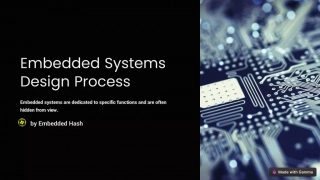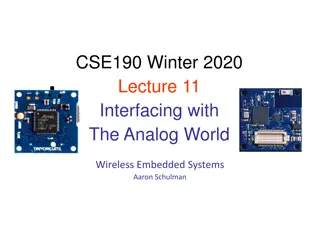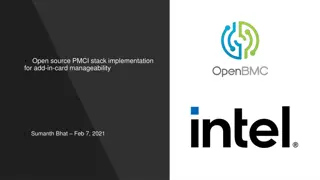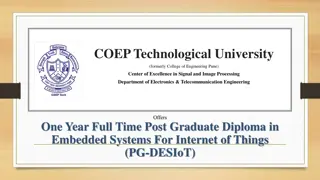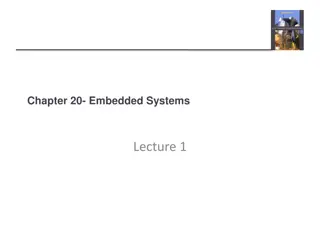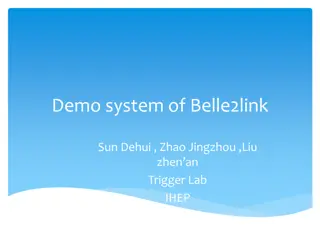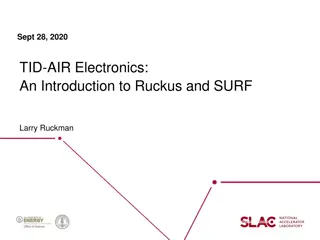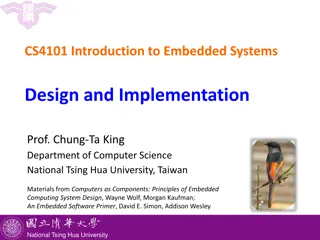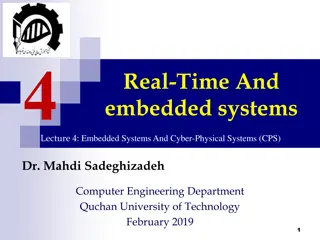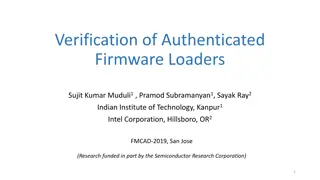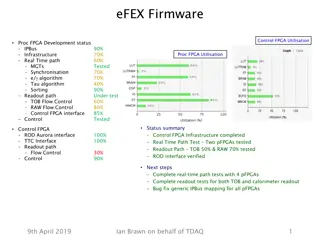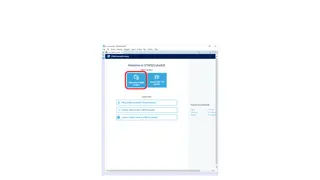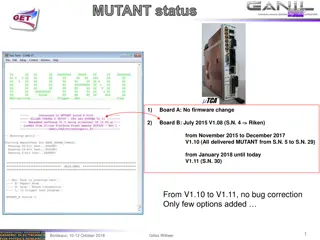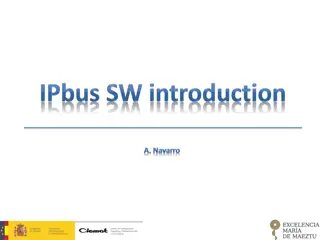
Understanding Firmware: Types, Environments, and Considerations
Explore the world of firmware, including its types like Bare Metal and RTOS, hardware environments, and key aspects like memory limitations and update challenges.
Download Presentation

Please find below an Image/Link to download the presentation.
The content on the website is provided AS IS for your information and personal use only. It may not be sold, licensed, or shared on other websites without obtaining consent from the author. If you encounter any issues during the download, it is possible that the publisher has removed the file from their server.
You are allowed to download the files provided on this website for personal or commercial use, subject to the condition that they are used lawfully. All files are the property of their respective owners.
The content on the website is provided AS IS for your information and personal use only. It may not be sold, licensed, or shared on other websites without obtaining consent from the author.
E N D
Presentation Transcript
Contacts Technical Questions: Erik Rainey erikrain@amazon.com Interested in working with us? For openings contact: Matt Sigman msigman@amazon.com
Public Information Drone is approximately 6ft across, 6 motors, Hexagonal shape, Hybrid VTOL Flies upwards of 60mph Carries <5 lbs package. Limited (but large) catalog of items. C++14 Firmware runs on the drone today More information at the end of the slides
Outline Brief Intro to Firmware & the Environment Embedded C++14 Restrictions Embedded C++14 Policies and Recommendations Later Specifications and Reference material
Brief Intro This is to help level-set your expectations This is just what we think A lot of things are covered in many other CppCon talks Not strictly about safety critical guidelines.
What is Firmware? Everyone has a slightly different take There will be a session later this week in this vein. Spectrum of complexity Many dimensions of constraint types Used across broad products categories in the industry Many caveats and special cases
What is Firmware? Usually, though not always: is software which is installed into the internal memory of a processor Has 1 execution context plus interrupts Runs as highly privileged (w.r.t. processor modes) Intentionally difficult to update Updates come as a single large image instead of piecemeal updates of individual parts Limited memory space environments Limited memory protection mechanisms
Many Types of Firmware In order of least complexity: Bare Metal Super Loop Firmware Real Time Operating Systems FreeRTOS, etc. Reduced Functionality Operating Systems ucLinux linux for micro-controllers Full Operating Systems, but with limited flexibility Symbian OS Some distributions of Linux for Routers (dd-wrt, tomato)
Hardware Environment Typically a micro-controller. Like an ARM Cortex M series but also covers many different architectures These class of devices: Do not have an MMU, have limited memory protection Have small but fast SRAM (< 1MB - few MB) some TCM too (1 cycle memory, even smaller) Have small flash (< 4MB) May have Single or Double floating point ops (or none) Run at Mhz ranges in Clock Speed Hardware Watchdog
Hardware Environment Frequently they must interact with low level, slower busses used in Industry. I2C, SMBus SPI, QSPI UART, RS-485 CAN, LIN Ethernet (<=100Mbps), TSN, EtherCAT, etc. Many others Devices need to have very fast boot times (<< 1 sec) Devices need to run for long extended periods with no issues May have a low power mode. May support ECC memory, Error Injections
What is a Super-loop Firmware Is conceptually just a big for loop There is a single execution context All executable tasks are visited once in the Super Loop then it repeats cl ass Task { publ i c: vi r t ual voi d Ex ecut e( voi d) = 0; } ; void TaskManager::RunAl l Tas ks ( ) { f or ( aut o& t as k : Get Tas kLi s t ( ) ) { t as k. Execut e( ) ; } } Tas k B Tas k A Task A Task C Task B Task C One Iteration
What is a Super-loop Firmware No software limit of execution time No guarantee of when next start time is Blocking constructs effectively halts the system No idle task* Consequently, always at 100% processor usage Metrics (usually trailing window): Min/Avg/Max Super Loop time Min/Avg/Max per Task time
What else is missing? No Heap No Virtual Memory No Threads, No Processes, No Scheduler No User Model No File System No Exception handling No blocking system calls
Why is that stuff missing? Eliminates entire classes of runtime errors No memory fragmentation error No runtime out of memory conditions No thread starvation, priority inversion, priority arrangement issues by the Scheduler. Less functionality means less things can go wrong Easier to reason about the system More deterministic, repeatable Reduces the testing burden Allows you to focus on solving the high level functionality including accounting for failure modes upfront.
Undefined Behavior Removes some open-ended, undefined behavior We have to consider what happens to the system if: Your kernel heap is full or is overly fragmented? Your kernel is deadlocked? Your kernel had an exception? Within the exception handler? UB is not an option in a critical environment If you have a Certification burden you have to know how your system will behave, even in severe error cases If something has an open-ended, undefined failure mode, it should be removed
Whats Left Many features of the language are still available with the remaining environment Using C++ s stronger type system allows us to be more sure that the right behaviors happens. We can be far more expressive with our hardware model. C++ can be used all the way down to bare metal And wrap the last few bits of assembler/builtins in good interfaces
System Environment Stacks System Calls (swi) Protect very few dangerous operations behind a barrier restarting, logging fatal errors, data cache operations, fetching keys Vector Table and Handlers Hard Faults, Bus Faults, etc Special libc (newlib/libnano) which is intended for embedded processors which is further restricted Still have printf but reduced functionality (maybe no %f, no 64 bit support) Even these tiny libraries make assumptions about what s available! Stub out functions like _sbrk grows the top of memory (_end) Normal Mode Stack Privileged Mode Stack (optional)
System Environment Standard Cross Compiler, but of the none variety arm-none-eabi-g++ There are very few default system assumptions like linker scripts, library support, binary formats, etc. Custom Linker Script with strict limits You can assert assumptions within the linker syntax If we statically allocate too much it won t build. This can apply to multiple regions, not just global memory DMA buffers, special low power RAM sections, etc. Moves runtime allocation problems to compile time problems.
System Environment We avoid most ISRs unless absolutely unavoidable. Some information is captured only in ISR context on some peripherals Some code must run within ISR to keep the control loop working This means most peripherals are polled
System Environment Using global memory space is generally bad practice in other situations. It s one of the only things available in this environment. Very little global memory is considered shared The boot path from the reset vector to main() is a progression of enabling various layers of feature support for C++ Stack Can only use hardcoded addresses to load/store values. No Globals available. crt0 Globals initialized and/or zeroed. Global Class Constructors Global Classes are constructed before main()
System Environment Must be aware when your Constructors are called relative to the boot sequence when those Objects are the system What has been enabled in the system? Can you make system calls? Are peripheral power/clocks enabled? Can other tasks run? Are ISRs enable yet per peripherals? Are the core systems running? Watchdog, Timer, the Pin Mux? Controlling Construction-time ends up being useful
Build Environment Built from a complete set of sources into a single binary All types are known at compile time Any unknown types in communication channels are ignored. The protocols we use have predefined enumerated types No new types are allowed at runtime New types cause a complete rebuild
Software Patterns Some data structures show up over and over again: Ring Buffers / FIFO / Circular Buffer Queues too (but they re really Ring Buffers) Containers which can control when contained objects are constructed Custom error code tuple-like object (result, cause, location) with mechanisms to capture location of problems Then write a constexpr set of valid combinations of these results and causes This permits us to break the build on ridiculous combinations of values. Bus Drivers use Queues of Transactions A system for orthogonal errors collection in normally unreportable locations (Constructors/Operators/void functions) Combines the error tuple and Ring Buffer Mostly will want to continue execution, rarely to assert/abort (which capture and reset)
Software Execution Execution environment dictates that most task code ends up looking like a Finite State Machine or a State Chart. Many good libraries, 3rd party tools to support this Abstracting this allows inner logic to be to run on off-target tests Better testing frameworks, more complete code coverage of the FSM/SC itself.
Software Execution These StateCharts are always written as non-blocking and concurrent Never, ever block the system from running! Process data in conceptual chunks, i.e. transactions, bulk transfers. Rarely ever single bytes. DMA engines used as much as possible. Function recursion is rarely used and generally avoided. Could overrun the (small) stack quickly If poorly done, could end up with the same blocking issue.
Super Loop Firmware on a Drone What type of systems use this type of solution? Simple Bus to Bus message bridging applications Controllers Examples are leaves in a graph topology Simple Sensors (Source) SPI/I2C Sensors to CAN publisher Data loggers (Sink) Capture all data on a bus into an eMMC. Controllers (Source + Sink) UART/CAN, PWM+ADC/CAN, I2C/CAN
Embedded C++14 Language Restrictions
Restrictions Strongly should avoid forever for/while loops Only 1 is allowed in the entire system in main(). Should avoid Loops without definite bounds without definite, testable exit conditions these could lead to stuck execution Use Timeouts, even counters as a fallback Choose do/while, while,for wisely! Otherwise, the Watchdog will get you.
Restrictions Should avoid pointers. use reference where possible In an MMU-less environment (like a micro-controller) some real memory may exist at address zero. Can t count on nullptr_t dereference for protection! Must not use Exceptions space constraints, recursive issues No throw/noexcept No try/catch Should not use Run Time Type Info all types are known at compile time. typeid() Must not use dynamic_cast<> Must not use Dynamic memory No new*/delete No malloc/free [gcc,clang, et al] Pass the compiler/linker -Wl,--wrap=malloc -Wl,--wrap=calloc Then never implement wrappers!
Restrictions With no dynamic memory, there s no way to consistently use many STL types. No resizable types like std::vector No allocatable types like std::unique_ptr Also some less obvious ones like std::bind Many things reallocate memory as needed! Even if there are ways to use a subset of the object s API, don t. Don t reinvent another Heap with Custom Allocators! The interface fails in the same way as before! It is the notion we are removing, not any specific implementations of Allocators.
The Stages of Heap Withdrawl 1. 2. I don t know how much memory I need at runtime, so I need a Heap. I know how much worst case memory I need at runtime but I still would like to use a Heap for convenience, even though my initial allocation could still technically fail . Well I could use a statically allocated pool of memory fixed sizes and manage usage bits with an allocator interface. 1. <Reinvents Heaps> Oh, that can still run out, so make an enum of preassigned pools! 1. <Reinvents static memory allocation> 3. 4. 5. Store static memory with the Objects that need it. Size it appropriately, protect against failure modes which could cause overruns.
Embedded C++14 Policies and Recommendations
Ask Compilers/Analyzers for help Turn on every warning Make them all errors Be as pedantic and strict as practical Know your compiler and know your use case. 3rd party includes may fail under this burden, have a plan Use compiler suggestions to improve code quality! Compile against static analyzers with even stricter rules Match your cross/host compiler versions if possible
Dont re-invent your own basic types Use <cstdint> Cross-Compilers generally know better than you Use uintptr_t, not uintXX_t to transport addresses Unit testing is important, even in low level code! using my_uint8 = unsigned char; // is that true on all of your platforms? using my_uint16 = unsigned short; using my_int32 = long; // is that really 32bits on your platforms? uint32_t PointerToAddress(void* ptr) { return reinterpret_cast<uint32_t>(ptr); // error on 64bit Platform } uintptr_t PointerToAddress(void *ptr) { return reinterpret_cast<uintptr_t>(ptr); // works everwhere }
Would you like my References? Use References everywhere you can Pointers should be rare There will be low level exceptions, vector tables, DMA, etc. With effort, their usage can be severally reduced, or isolated Even Hardware Objects like Peripherals should be references! // declare as a reference Foo &foo = context.GetFoo(); foo.bar(); // pass as a reference void SomeFunc(Foo& foo); // Reference to Peripheral via placement new into a reference Peripheral& perph = *new(PERIPH_ADDRESS) Peripheral{}; // Drivers should take references to other Drivers, Buffers Driver(Timer& timer, std::array<uint8_t, 1024>& dma_buffer);
namespace Unlearning C namespacing is hard. Mental Frames are difficult to dislodge Commit to C++ namespacing 100% // DON T half-way commit to C++ naming namespace Chip { enum class ComponentMode { ComponentModeFreeRunning }; class ComponentPeripheral { static void IntializePeripheral(ComponentMode mode) = 0; }; } // DON T Chip::ComponentPeripheral::IntializePeripheral( Chip::ComponentMode::ComponentModeFreeRunning );
DRY Keep names DRY Don t repeat yourself Keep enums and classes properly scoped to the level they are used Keep functionality related to the peripheral hardware in the peripheral class // DO namespace Chip { namespace Component { class Peripheral { enum class Mode : { FreeRunning }; static void Initialize(Mode mode); }; } } // DO Chip::Component::Peripheral::Initialize( Chip::Component::Peripheral::Mode::FreeRunning );
Layer-cake of Classes Layers interact through Pure Virtual Interfaces Enforces good separation between implementation details and common set of objects. Virtual overhead is something to keep an eye on but utility and design often wins // interface class Foo { public: virtual uint64_t GetCount(void) const = 0; }; // implementation class Bar : public Foo { public: uint64_t GetCount() const override { }; };
Virtual Diamonds No diamond virtual inheritance patterns Compilers stops overt bad behavior Don t try to make it work, redesign your Hierarchy or Models class Foo { public: }; class Bar : public Foo { public: size_t GetCount() const override { } }; class Baz : public Foo { public: size_t GetCount() const override { } }; class Gaf : public Bar, public Baz {}; virtual size_t GetCount() const = 0; Gaf g{}; // where is it from?! g.GetCount();
The final frontier Use final when appropriate This controls what can be subclassed and what can not. Customers need to know what is flexible and what is not. // Interface to a Controller class IController { }; // implementation has an interface and can not be subclassed class ControllerImpl final : public IController { }; // an attempt to subclass class MyController : public ControllerImpl { // error!
RAII Resource Acquisition is Instantiation (RAII) A good practice in general C++ An essential practice in Embedded C++ When using placement new, objects must be destructed manually! With no Heap, this mainly applies to Hardware use class DriverImpl { DriverImpl(volatile Peripheral& peripheral, ) : periph(peripheral) { periph.configure( ); periph.enable(); } ~DriverImpl() { // must be called explicitly periph.disable(); } };
Fall inline Only inline simple methods class Foo { public: inline size_t GetCount() const { return count_; } // DO inline size_t ApproximatePiFromTheMoon(Image& moon) {...} // DON T Protected: size_t count_; };
My const companion Be as const as you can stand! This helps inform users about side-effects This may require some consideration for const and non-const use cases. class Foo { public: const char * const Bar(const char * const, ) const; inline const size_t& GetCount() const { return count_; } protected: size_t count_; }; // the methods invoked on the object must be const too bool SomeFunc(const Foo& obj) { };
But... Hardware is Weird Methods which use const truly should have no side-effects! Read and Clear (or Clear After Read) register functions should not be marked const Side effects should be called out Wrapping classes may need to remember state on behalf of this HW. class SimulatedHardwareReadAndClearStatusRegister { public: enum class StatusCode : uint8_t {WAITING = 0x0, BUSY = 0x1, COMPLETE = 0x80}; StatusCode GetStatus() const { // acts like a Read and Clear Register, problematic! auto tmp = value_; value_ &= ~0x80; // actually modifies status bits! return static_cast<StatusCode>tmp; } protected: mutable uint32_t value_; }; class ReadAndClearStatusRegister { public: enum class StatusCode : uint8_t {WAITING = 0x0, BUSY = 0x1, COMPLETE = 0x80}; // DON T mark as const, will modify itself. StatusCode GetStatus() { return static_cast<StatusCode>(value_); } protected: uint32_t value_; };
Hardware can be volatile Use volatile to describe Memory Mapped Registers & Hardware This can have cascading side effects! Methods may need to be volatile too! This can help tests on non-native systems avoid weirdness in simulation. namespace Chip { struct Peripheral { Peripheral() : {} // initialize to good values (Hardware may not like initializing in that order!) uint32_t CONTROL; uint32_t MODE; uint32_t STATUS; }; class DriverImpl : public Driver { public: DriverImpl(volatile Chip::Peripheral& ref) : m_periph{ref} {} protected: volatile Peripheral& m_periph; }; } // in the context volatile Chip::Peripheral& periph0 = *::new(PERIPH_ADDRESS) Chip::Peripheral{}; Driver& driver0 = Chip::DriverImpl{periph0};
Mutability Avoid mutable unless you absolutely need it Metrics collectors Try-Locking mechanisms (no blocking!) class Baz { public: protected: }; class Foo { public: protected: }; bool Check(void) const { if (not lock_.trylock()) { return false; } // operation on shared resource lock_.unlock(); // determine success } void bar() const { // call_count++; // mutable } const size_t& GetCallCount() const { return call_count_; } mutable Lock lock_; mutable size_t call_count_;
The atomic age Use std::atomic types to share data between Tasks and ISRs Critical Sections tend to be implemented using atomics READ the docs. std::atomic<> has some gotchas! class CriticalSection { public: bool trylock() {} bool unlock() {} protected: std::atomic<uint32_t> count_; }; // See atomics video from CppCon!
Control your Constructors staticstorage definitions can be used to allow global object Construction phases to be controlled Sequence and Lifetime must be thought through! /// Somewhere in global memory static std::aligned_storage<sizeof(Foo), alignof(Foo)>::type storage; void main(void) { // object initialization happens in preallocated global memory Foo &foo1 = *::new(&storage) Foo{ }; // } // object initialization happens on stack Foo foo2{ };
#ifdef nope Avoid #define macros and #ifdef as much as possible Convert to templates with parametric size constexprs #define NUM_BYTES (20) uint8_t myArray[NUM_BYTES]; // DON T // DO static constexpr size_t num_bytes = 20u; std::array<uint8_t, num_bytes> myArray; // DON T #define DEBUG // file local debug flag (wait for C++17 for full support but you can declare this now!) static constexpr bool debug = true;
Be as constexpr as possible Simple classes should have constexpr constructors Write testable assertions using constexprs Use the compiler to test your code Keep these anonymous tests in source files, not headers if possible. Ensure the Linker removes unreferenced code // in header constexpr uint32_t foo(uint32_t) { } // in source namespace { constexpr uint32_t foo_test[] = {foo(X), foo(Y)}; static_assert(foo_test[0] == 0x10, Must be true or something is wrong ); } // anonymous // On Constructors class Foo final { constexpr Foo() : {} };

